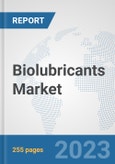Biolubricants, also known as sustainable, eco-friendly, or biodegradable lubricants, encompass a wide range of lubricating substances that possess two key characteristics: easy biodegradability and non-toxicity to both humans and the environment. While the utilization of biolubricants remains limited compared to mineral oils, there is a growing trend towards their increased application, contingent upon investment in research and development (R&D). Bio-lubricants serve as viable alternatives to petroleum-based oils, offering several advantages. They readily biodegrade and do not pose harm to humans or aquatic ecosystems. As such, they are considered more environmentally friendly than traditional lubricants. The transportation and manufacturing sectors are expected to witness a surge in the adoption of biolubricants, driving global demand. This heightened demand can be attributed to the rising awareness and understanding of environmental concerns, the enforcement of stringent regulations, and the growing market acceptance of bio-based lubricants.
The hydraulic fluids segment dominated the market share in the biolubricants industry. Bio-based lubricants are frequently employed as hydraulic fluids to enhance the performance of machinery such as harvesters, cranes, tractors, and load carriers in forest operations. Recognizing this market opportunity, numerous bio-based lubricant manufacturers are proactively developing products specifically tailored for applications where spills are more likely or where lubricants are prone to loss during usage. These manufacturers are focused on designing solutions that address the specific needs and vulnerabilities of such areas and applications.
North America emerged as the dominant market for biolubricants in 2021, and its strong position is expected to be maintained throughout the forecast period. The revitalization of the automotive industry in the United States and Canada is set to drive the global market, supported by increased regulatory interventions by the U.S. government concerning the usage of conventional lubricants. Furthermore, the U.S. Air Force considers plant-derived biodegradable products as a strategic and fundamental approach to national defense, providing an additional impetus to the market. The escalating governmental expenditure on bio-lubricants in the marine and automotive sectors is poised to create lucrative opportunities for market growth.
Report Findings
1) Drivers
- The market for biolubricants is experiencing significant growth primarily due to their environmental benefits.
- The growing consumer preference for bio-based products in various industries such as automotive, industrial machinery, and marine sectors is expected to stimulate the market's growth.
2) Restraints
- The potential higher production costs associated with biolubricants in comparison to petroleum-based lubricants hamper the growth of the market.
3) Opportunities
- Continuous research and development (R&D) endeavors aimed at improving the performance characteristics of biolubricants can pave the way for significant growth opportunities.
Research Methodology
A) Primary Research
The primary research involves extensive interviews and analysis of the opinions provided by the primary respondents. The primary research starts with identifying and approaching the primary respondents, the primary respondents are approached include1. Key Opinion Leaders
2. Internal and External subject matter experts
3. Professionals and participants from the industry
The primary research respondents typically include
1. Executives working with leading companies in the market under review2. Product/brand/marketing managers
3. CXO level executives
4. Regional/zonal/ country managers
5. Vice President level executives.
B) Secondary Research
Secondary research involves extensive exploring through the secondary sources of information available in both the public domain and paid sources. Each research study is based on over 500 hours of secondary research accompanied by primary research. The information obtained through the secondary sources is validated through the crosscheck on various data sources.The secondary sources of the data typically include
1. Company reports and publications2. Government/institutional publications
3. Trade and associations journals
4. Databases such as WTO, OECD, World Bank, and among others.
5. Websites and publications by research agencies
Segment Covered
The global biolubricants market is segmented on the basis of type, application, and end-use industry.The Global Biolubricants Market by Type
- Vegetable Oil
- Animal Oil
The Global Biolubricants Market by Application
- Engine Oils
- Gear Oils
- Hydraulic Oils
- Greases
- Metal Working Fluids
- Sterntube Oils
- Others
The Global Biolubricants Market by End-use Industry
- Industrial
- Marine
- Others
Company Profiles
The companies covered in the report include
- RSC Bio Solutions
- Cargill
- Lubmarine
- Exxon Mobil Corporation
- TotalEnergies
- PANOLIN AG
- Christensenusa
- Carl Bechem Lubricants India Private Limited
- FUCHS
- Environmental Lubricants Manufacturing, Inc.
What does this Report Deliver?
1. Comprehensive analysis of the global as well as regional markets of the biolubricants market.2. Complete coverage of all the segments in the biolubricants market to analyze the trends, developments in the global market and forecast of market size up to 2030.
3. Comprehensive analysis of the companies operating in the global biolubricants market. The company profile includes analysis of product portfolio, revenue, SWOT analysis and latest developments of the company.
4. Growth Matrix presents an analysis of the product segments and geographies that market players should focus to invest, consolidate, expand and/or diversify.
Table of Contents
Companies Mentioned
- RSC Bio Solutions
- Cargill
- Lubmarine
- Exxon Mobil Corporation
- TotalEnergies
- PANOLIN AG
- Christensenusa
- Carl Bechem Lubricants India Private Limited
- FUCHS
- Environmental Lubricants Manufacturing, Inc.








